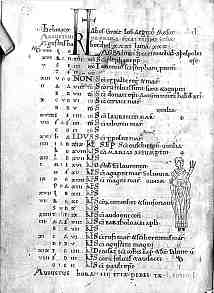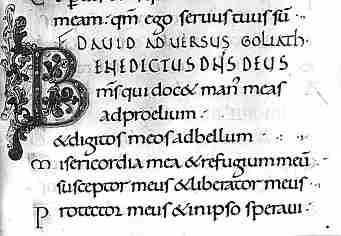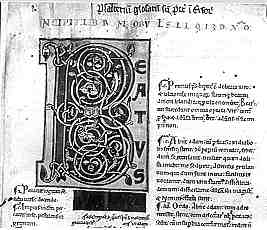




If you are looking at this page without frames, there is more information about medieval writing to be found by going to the home page (framed) or the site map (no frames).
| The Psalter (2) | |||
 |
At left, the calendar page for August in the Arundel Psalter (British Library, Arundel 60, f.5v), by permission of the British Library. Below, a detail of some of the calendar entries. | ||
| The calendar, as shown on this 11th century example, contained a list of the feasts of saints as well as the major church festivals. In these earlier examples, the dates were entered in the old Roman system of kalens, nones and ides. This page depicts the zodiac figure for the month, Virgo, as was common in calendars throughout the middle ages. There is also an assortment of mysterious letter and number code which allowed the computation of Sundays, new moons and Easter for any given year. It is packed with coded information. | |||
| To learn a bit more about reading this information, go to the Reading a Calendar section of this website. | |||
 |
|||
| Despite the authoritarian nature of the church, the liturgy was not identical in all areas of western Christendom. There were differences between dioceses in the saints' feasts celebrated and the order of psalms or other details of the spoken and sung liturgy. This is referred to as the use, and liturgical books are described as use of Rome, use of Paris, use of Sarum (Salisbury), depending on where they were designed for. With the psalter, the calendar may provide the best clue as to the use of the volume from the minor or local saints listed. | |||
 |
Segment from the late 10th century Ramsay Psalter (British Library, Harley 2904, f.1810, by permission of the British Library. | ||
| While this example from the psalter text itself is in a large and bold Caroline minuscule hand, suggesting that it might be legible even in the gloom of the enclosed choir of Ramsey Abbey, for which it was written, there are numerous graphic signs to aid study and oral performance. | |||
| The large initial B is an obvious place marker, while the rustic capital majuscule script introduces a significant point in the text. Each verse has an enlarged capital set apart from the line. The text is arranged according to a system called per cola et commata, which basically means that instead of filling up the page with continuous text, the line breaks reflect the way in which the text should be read aloud. Furthermore, there is a complex set of punctuation marks employed which indicate the weight of the pauses at the end of each line, and probably other subtleties of diction. Although it is a formal manuscript, there is considerable abbreviation. In other words, this text is not designed for the mindless recitation of spelled out syllables and words, it is coded for the projection of meaning. | |||
 |
Page from the early 12th century Melissande Psalter (British Library, Egerton 1139, f.210), by permission of the British LIbrary. | ||
| This work represents an early example of a psalter commissioned for a lay person, in this case Queen Melissande, wife of Fulk of Anjou. It is not possible to know how much Latin literacy this lady had acquired residing in what was essentially an outpost colony of Europe in Jerusalem, but it is more than likely that the psalter text would have been used by her private chaplain than read by the lady herself. It does contain something that was to become more common in psalters for private use, and that is a set of prayers to various saints. That shown at left is to Mary Magdalen, and is headed by a striking miniature of the saint. The Latin text is in simple rhymning couplets with a regular metre, just the thing for memorising by a lay person whose Latin was less accomplished than that of the churchmen. | |||
 |
Detail from the beginning of a 12th century glossed psalter for the monastery of St Peter at Hereford (British Library, add. ms. 10924, f.1), by permission of the British Library. | ||
| At the same time, psalters produced for the monasteries could contain the typical medieval academic accretions that made them works for serious study. In this glossed psalter the very first word of Psalm 1, Beatus, rendered in a typical jungly form, is completely surrounded by closely written gloss before you even get to the second word, vir, not even visible on this photograph. | |||
| In the 13th and 14th centuries prestige psalters, whether produced for monasteries or for wealthy lay patrons, developed a particular style and appearance. At one level they are works of art, as the miniatures and historiated initials represent some very fine paintings of the period. At another level, the artistic elements can all contribute to the process of memorising and delivering the work in the liturgy. Some of the motifs refer directly to the text on the page. In other cases the connections may be there, but may be enigmatic to us. Then there are motifs whose relevance is quite obscure, but they provide an image which can be associated with a recognised text. | |||
| |
|||
If you are looking at this page without frames, there is more information about medieval writing to be found by going to the home page (framed) or the site map (no frames). |
|||